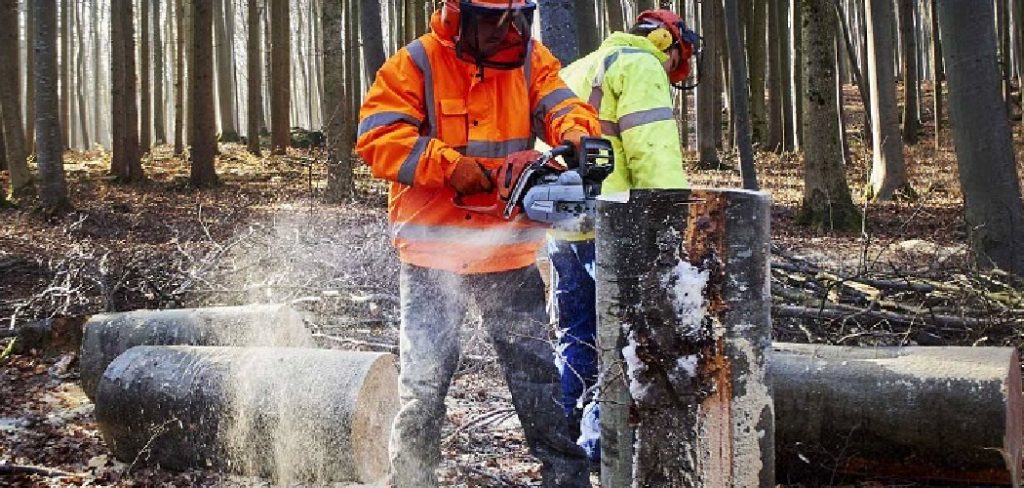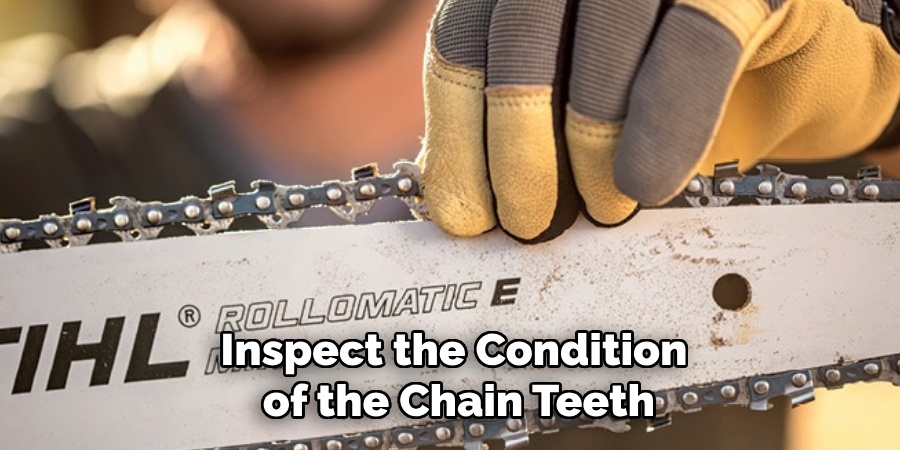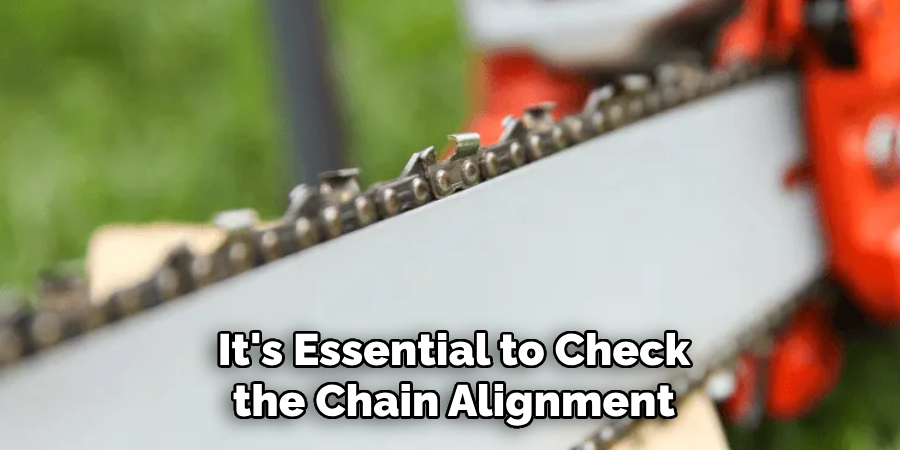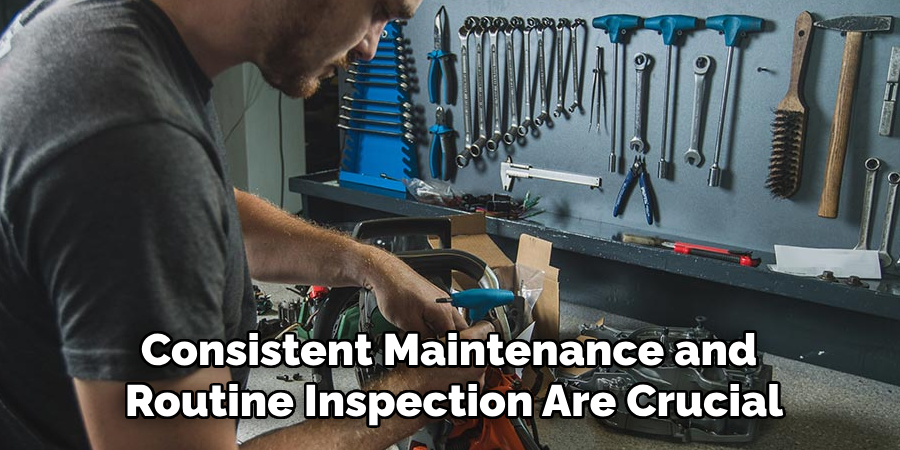Are you having trouble getting your chainsaw to cut straight? Cutting to the right can be frustrating, especially when making precise cuts.
When a chainsaw begins cutting to the right instead of making a straight cut, it can be frustrating and potentially dangerous. Understanding the possible reasons behind this issue is essential to ensure the tool’s optimal performance and safety. Several factors can contribute to this problem, such as chain tension, unevenly sharpened teeth, or bar wear. Addressing these underlying issues with proper maintenance and care will not only correct the cutting problem but also extend the lifespan of your chainsaw.

In this guide, we will explore common causes and provide step-by-step solutions on how to fix chainsaw cutting to the right.
What Will You Need?
Before we get into the steps to fix your chainsaw, you will need a few tools and materials:
- A flat surface to work on
- A screwdriver or wrench
- A file or sharpening tool
- A cloth for cleaning
Once you have gathered all the necessary items, you can follow the steps below to fix your chainsaw’s cutting problem.
10 Easy Steps on How to Fix Chainsaw Cutting to the Right
Step 1: Check Chain Tension
The chain tension is the first thing to check when your chainsaw is cutting to the right. A loose or tight chain can cause the saw to veer off course and cut at an angle. To check the tension, turn off the chainsaw and let it cool down before proceeding. Then, use a screwdriver or wrench to adjust the chain tension by tightening or loosening the bar nuts. Ensure there is enough slack for the chain to move freely but not too much that it hangs loosely on the guide bar.
Step 2: Inspect Chain Teeth

Next, inspect the condition of the chain teeth, as unevenly sharpened teeth are a common cause of a chainsaw cutting to the right. Each tooth should have equal length and sharpness to ensure a straight cut. Use a file or sharpening tool to even out the teeth, filing each one down to match the size of the others. Be sure to maintain the correct angle while sharpening and follow the manufacturer’s guidelines for your specific chainsaw model. Regular sharpening of the chain improves performance and extends its lifespan.
Step 3: Examine the Chainsaw Bar
The chainsaw bar, also known as the guide bar, is crucial in how well your chainsaw cuts. An uneven or worn-out bar can cause the chain to misalign, leading to a biased cut to the right. Start by visually inspecting the bar for any signs of wear, such as grooves or ridges on the edges. If the bar shows significant wear or damage, it may need to be replaced. Use a straight edge to ensure the bar is flat and even.
A bent or warped bar should be straightened or replaced to ensure proper alignment during cutting. It’s also essential to clean the bar’s groove and oil holes to prevent any debris buildup that might hinder the chain’s movement. Proper maintenance and timely replacement of the chainsaw bar will help maintain accurate cuts and ensure safe operation.
Step 4: Align the Chain

Once you’ve ensured that the chain’s teeth are even and the bar is in good condition, it’s essential to check the chain alignment. A misaligned chain can cause the chainsaw to pull in one direction, leading to a skewed cut. Ensure the chain is correctly seated on the sprocket and guide bar. Rotate the chain manually to check for smooth movement around the bar without any binding or tight spots. If the chain appears to jump or slip, reposition it and check the tension once again. Ensuring correct alignment will contribute to straighter cuts and smooth operation.
Step 5: Check the Sprocket
The sprocket is another critical component that can affect the chainsaw’s cutting alignment. A worn or damaged sprocket can cause the chain to skip or bind, resulting in uneven cuts. To check the sprocket, first ensure the chainsaw is turned off and has cooled down. Remove the clutch cover to access the sprocket and inspect it for signs of wear, such as grooves or sharp edges. Replace the sprocket if any noticeable damage might interfere with the chain’s movement. Regularly inspecting and replacing a worn sprocket will ensure smooth chain rotation and contribute to straight, accurate cuts.
Step 6: Lubricate the Chain

Proper lubrication is essential for the efficient operation of a chainsaw as it minimizes friction between the chain and the guide bar. An inadequately lubricated chain can overheat, cause excessive wear, and may lead to cuts veering to one side. Check the oil reservoir to ensure it contains enough lubricant and that the oiling mechanism functions correctly. Apply chain oil to the bar and chain before each use, and regularly check the oil flow while the chainsaw is operating. Keeping the chain well lubricated reduces wear and helps maintain accurate and safe cutting.
Step 7: Adjust the Depth Gauges
Depth gauges, or rakers, limit how deep the cutting teeth penetrate the wood. If the depth gauges are set too high, the chain won’t cut efficiently, while if they’re too low, the chain may dig too aggressively, resulting in rough or uneven cuts. To adjust the depth gauges, use a depth gauge tool to measure their height compared to the chain teeth. Using a flat file, gently file down any high points to the recommended height indicated in your chainsaw’s manual. Consistently adjusting the depth gauges ensures a smoother, more controlled cutting experience and helps prevent the chainsaw from veering off course.
Step 8: Ensure Proper Posture and Technique
Operator posture and cutting technique can significantly influence the accuracy of your chainsaw cuts. Stand with your feet shoulder-width apart and maintain a balanced stance. Hold the chainsaw firmly, keeping your elbows slightly bent to absorb vibrations during cutting. Position your body directly behind the saw to maintain control and sight of the cutline. Avoid overreaching or cutting above shoulder height, as this compromises alignment and safety. Practicing good posture and technique increases precision and reduces the likelihood of veering cuts.
Step 9: Regular Maintenance and Inspection

Consistent maintenance and routine inspection are crucial for your chainsaw’s long-term performance and safety. Schedule regular check-ups where you thoroughly clean and inspect all components, including the air filter, spark plug, and fuel lines. Replace these parts as necessary following the manufacturer’s recommendations. Additionally, ensure that all screws and bolts are tightened securely to prevent any loose parts during operation. A well-maintained chainsaw not only improves cutting efficiency and accuracy but also extends the tool’s lifespan and ensures safe and reliable usage.
Step 10: Test the Chainsaw
Before tackling any major cutting projects, it’s vital to test the chainsaw to ensure that all adjustments and maintenance have been effective. Begin by starting the chainsaw and letting it idle for a few minutes to warm up. Observe the chain movement on the bar to ensure smooth rotation without any slipping or binding. Use a piece of scrap wood to perform a series of test cuts, paying close attention to the accuracy and ease of cutting. Review and repeat the relevant maintenance steps if the chainsaw veers to one side or struggles to penetrate the wood. Successful test cuts indicate that your chainsaw is adjusted correctly and ready for efficient and precise use.
By following these steps, you can ensure that your chainsaw is adjusted correctly and maintained for accurate and safe cutting.
5 Things You Should Avoid
- Ignoring Chain Tension: Ensure that the chainsaw chain is properly tensioned. A chain that is too loose or too tight can lead to uneven cutting, so steer the cut to the right. Regularly check and adjust the tension according to the manufacturer’s recommendations.
- Using a Dull Chain: A dull chain can cause the chainsaw to cut unevenly. Always keep the chain sharp by regular sharpening or replacing it when necessary. A sharp chain will cut wood more efficiently and help prevent the saw from veering to one side.
- Neglecting Guide Bar Maintenance: An unevenly worn guide bar can cause the saw to cut to the right. Inspect the guide bar for any signs of wear, such as burrs or uneven edges, and address these promptly to ensure even cuts.
- Improper Chain Filing: If the teeth on one side of the chain are filed more aggressively than the other, the chainsaw may cut to the right. Ensure the chain teeth are filed evenly and regularly to maintain a straight cut.
- Overlooking Powerhead Alignment: Misalignment between the powerhead and the guide bar can lead to off-balance cuts. Confirm that the alignment is correct and that all components are securely fastened to prevent uneven cutting.
Conclusion
Conducting regular maintenance and inspections is crucial to addressing the issue of a chainsaw cutting to the right.
Ensure the chain tension is neither loose nor tight, as improper tension can skew cut accuracy. Keep the chainsaw chain sharp by sharpening it regularly or replacing it when needed, enhancing cutting efficiency and precision. Pay attention to the guide bar by inspecting it for wear and maintaining its evenness. Proper chain filing is essential; ensure teeth are evenly filed to prevent steering imbalances. Lastly, check the alignment between the powerhead and the guide bar to ensure a balanced operation.
Hopefully, the article on how to fix chainsaw cutting to the right has been informative and helpful. By following these tips, you can maintain an accurately cutting chainsaw that is safe and efficient to use.
Edmund Sumlin is a skilled author for Metal Fixes, bringing 6 years of expertise in crafting a wide range of metal fixtures. With a strong background in metalwork, Edmund’s knowledge spans various types of fixtures, from decorative pieces to functional hardware, blending precision with creativity. His passion for metalworking and design has made him a trusted resource in the industry.
Professional Focus:
- Expert in Metal Fixtures : Edmund aesthetic specializes in creating durable and innovative metal fixtures, offering both appeal and functionality. His work reflects a deep understanding of metalworking techniques and materials.
- Sustainability Advocate : He is dedicated to using sustainable practices, ensuring that every fixture is crafted with eco-friendly methods while maintaining high-quality standards.
In his writing for Metal Fixes, Edmund provides valuable insights into the latest trends, techniques, and practical advice for those passionate about metal fixtures, whether they are professionals or DIY enthusiasts. His focus on combining artistry with engineering helps others discover the true potential of metal in design.


